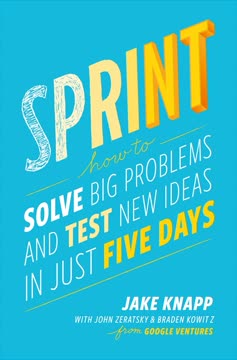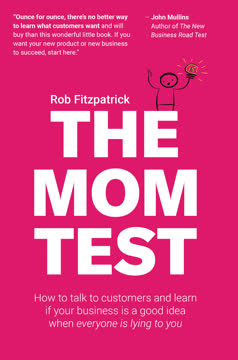Key Takeaways
1. Product Marketing: The Foundation of Tech Product Success
Product marketing's purpose is to drive product adoption by shaping market perception through strategic marketing activities that meet business goals.
Misunderstood yet crucial. Product marketing is often misunderstood as just creating collateral or managing launches, but it's far more strategic. It's the foundation upon which all other marketing activities build, driving product adoption by shaping market perception.
Bridge between product and market. Product marketers serve as the crucial link between product development and go-to-market teams. They translate customer and market insights into actionable strategies, ensuring that products not only solve real problems but are also positioned and communicated effectively to resonate with target audiences.
Strategic impact on business. By aligning product capabilities with market needs and communicating value effectively, product marketing directly impacts key business metrics:
- Customer acquisition and retention
- Market share growth
- Revenue generation
- Brand positioning in competitive landscapes
2. The Four Fundamentals: Ambassador, Strategist, Storyteller, Evangelist
Product marketing brings strategic intent and product insight to all market-facing activities.
Ambassador: Connect insights. Product marketers must deeply understand customers, markets, and products. They:
- Conduct customer interviews and market research
- Analyze competitive landscapes
- Translate insights for product and go-to-market teams
Strategist: Guide go-to-market. They develop comprehensive strategies that:
- Align with business goals
- Define target segments and positioning
- Guide marketing mix and sales enablement
Storyteller: Shape perceptions. Crafting compelling narratives that:
- Articulate product value clearly
- Resonate with target audiences
- Differentiate from competitors
Evangelist: Enable others. Empowering the entire organization to tell the product story:
- Equip sales teams with effective tools and training
- Collaborate with marketing on campaigns
- Engage influencers and partners
3. Market Fit: Continuous Discovery and Adaptation
Probe early, probe often.
Never assume, always validate. Market fit isn't a one-time achievement but a continuous process of discovery and adaptation. Product marketers must constantly probe the market to understand evolving customer needs, competitive dynamics, and product-market alignment.
Tools for discovery. Employ a mix of quantitative and qualitative methods:
- Customer interviews and surveys
- Usage data analysis
- A/B testing of messaging and features
- Competitive analysis
- Sales feedback loops
Adapt swiftly. Use insights to guide:
- Product roadmap adjustments
- Messaging refinements
- Target segment shifts
- Go-to-market strategy pivots
4. Positioning and Messaging: Clarity and Authenticity Matter
Good messaging feels natural and obvious. It's harder to see what makes it good: anticipating what people need to hear—be it just the facts to something more aspirational.
Positioning is long-term. It's the place your product occupies in customers' minds, differentiating you from competitors. Crafting a strong position requires:
- Deep understanding of customer needs
- Clear articulation of unique value
- Consistency across all touchpoints
Messaging is adaptable. While supporting the overall positioning, messaging can be tailored for:
- Specific audience segments
- Different stages of the buyer journey
- Timely market opportunities or challenges
CAST framework for effective messaging:
- Clear: Easy to understand, drives curiosity
- Authentic: Resonates with customer realities
- Simple: Highlights key differentiators concisely
- Tested: Validated in real-world contexts
5. Go-to-Market Strategy: Aligning Product, Marketing, and Sales
A product go-to-market is strong and strategic when all its activities line up to achieve larger goals that incorporate current market realities.
Holistic approach. An effective go-to-market strategy aligns all customer-facing aspects of the business:
- Product development priorities
- Marketing campaigns and channels
- Sales processes and enablement
- Customer success and support
The Product Go-to-Market Canvas. A powerful tool for alignment, capturing:
- Customer and market realities
- Product milestones
- Key marketing strategies
- Critical go-to-market activities
Cross-functional collaboration. Success requires:
- Regular communication between product, marketing, and sales teams
- Shared goals and metrics
- Agile processes to adapt to market feedback
6. Brand and Pricing: Levers for Strategic Advantage
Brand isn't done well by most tech companies because it is largely misunderstood. It is presumed to be a company's name, logo, colors, design, and tone of voice—all things Netflix also does very well. Brand includes all this, but it is more about a consistent experience across every aspect of how a company acts—it's a promise between a customer and a company.
Brand as experience. In tech, brand is primarily driven by product experience, but extends to every customer touchpoint:
- Product functionality and design
- Customer support interactions
- Sales processes
- Marketing communications
Pricing as value engineering. Effective pricing strategies:
- Reflect perceived value, not just costs
- Consider competitive landscapes
- Align with go-to-market models (e.g., freemium, enterprise)
- Use packaging to serve different segments or use cases
Strategic tools. Both brand and pricing can be used to:
- Differentiate in crowded markets
- Signal quality or innovation
- Enable expansion into new segments or verticals
- Drive customer loyalty and retention
7. Evolving Product Marketing Through Company Stages
The key at any stage is to be unafraid to adapt the scope of the role and to communicate it clearly when you do.
Early stage: Ignition. Focus on:
- Rapid learning and iteration
- Discovering product-market fit
- Developing initial messaging and positioning
- Creating foundational sales enablement tools
Growth stage: Rapid rise. Priorities shift to:
- Scaling go-to-market operations
- Refining target segments and messaging
- Expanding product portfolios
- Building robust competitive positioning
Mature stage: Peak burn. Emphasis on:
- Maintaining market leadership
- Entering new markets or verticals
- Managing complex product portfolios
- Driving efficiency in go-to-market operations
8. Hiring and Developing Strong Product Marketing Talent
Hiring well is the most impactful thing leaders can do for product marketing. It's worth being rigorous in how you interview and assess.
Key skills to assess:
- Deep customer curiosity and active listening
- Product and technical competence
- Strategic thinking and execution ability
- Strong communication (written and verbal)
- Collaboration and cross-functional leadership
Interview techniques:
- Situational questions to assess adaptability
- Case studies to evaluate strategic thinking
- Writing samples to gauge communication skills
- Role-playing exercises for sales enablement abilities
Career development:
- Provide opportunities for cross-functional exposure
- Encourage continued market and customer engagement
- Offer leadership opportunities on key initiatives
- Support ongoing learning in marketing and product management
9. Leading Product Marketing: Organizational Dynamics and Best Practices
Product marketers succeed when they are willing to challenge a conversation based on customer insights.
Organizational structure considerations:
- Reporting line (marketing vs. product)
- Alignment with product teams
- Integration with go-to-market functions
Best practices for leaders:
- Clearly define and communicate the role's scope
- Foster strong cross-functional relationships
- Implement processes for ongoing market learning
- Establish metrics that tie to business outcomes
Creating inclusive team environments:
- Encourage diverse perspectives
- Promote psychological safety for open debate
- Recognize and leverage individual strengths
- Model continuous learning and adaptation
Last updated:
FAQ
What's Loved: How to Market Tech Products Customers Adore about?
- Focus on Product Marketing: The book emphasizes the critical role of product marketing in driving product adoption and shaping market perception.
- Four Fundamentals: It introduces four key fundamentals—Ambassador, Strategist, Storyteller, and Evangelist—that guide effective product marketing.
- Real-World Examples: Martina Lauchengco shares insights from her experiences at Microsoft and Netscape, illustrating successful product marketing strategies.
Why should I read Loved: How to Market Tech Products Customers Adore?
- Practical Guidance: Offers actionable strategies and frameworks for both beginners and seasoned professionals in product marketing.
- Industry Insights: Provides insider knowledge from Lauchengco's extensive experience in tech companies.
- Customer-Centric Focus: Emphasizes understanding customer needs and market dynamics to develop effective go-to-market strategies.
What are the key takeaways of Loved: How to Market Tech Products Customers Adore?
- Importance of Product Marketing: Highlights that product marketing is foundational to a product's success, not just an afterthought.
- Four Fundamentals: The roles of Ambassador, Strategist, Storyteller, and Evangelist are essential for connecting insights to market strategies.
- Iterative Learning: Stresses the need for continuous learning and adaptation in product marketing to understand market fit and customer needs.
What are the four fundamentals of product marketing outlined in Loved?
- Ambassador: Connects customer and market insights to inform product marketing strategies.
- Strategist: Directs the product's go-to-market efforts, aligning marketing activities with business goals.
- Storyteller: Crafts narratives that shape how the world perceives the product.
- Evangelist: Enables others to share the product's story, fostering a community of advocates.
How does Loved define effective messaging?
- Clear and Authentic: Messaging should be clear, authentic, and simple to resonate with the target audience.
- Customer-Centric Language: Encourages using language that highlights benefits rather than just features.
- Testing and Iteration: Emphasizes the importance of testing messaging in real-world contexts to refine its effectiveness.
What is the role of an Ambassador in product marketing according to Loved?
- Connect Customer Insights: Focuses on gathering and connecting customer and market insights to inform strategies.
- Market Sensing: Engages in market sensing to identify trends and competitive dynamics.
- Facilitate Communication: Acts as a bridge between the product team and the market, ensuring effective communication.
How does the Strategist function guide product go-to-market in Loved?
- Define Go-to-Market Plans: Responsible for creating a clear product go-to-market plan that aligns with business goals.
- Iterative Approach: Involves testing and refining strategies based on market feedback and performance metrics.
- Aligning Tactics with Goals: Ensures that marketing activities are aligned with overall business objectives.
What does it mean to be a Storyteller in product marketing according to Loved?
- Shape Market Perception: Crafts compelling narratives that shape how the world thinks about a product.
- Messaging Development: Develops key messages that reinforce the product's value proposition.
- Long-Term Positioning: Involves building a narrative that evolves with the product and its market over time.
How does the Evangelist role enable others to tell the product story in Loved?
- Empower Sales Teams: Provides sales teams with tools and resources to communicate the product's value.
- Engage Influencers: Identifies and engages key influencers and customers who can advocate for the product.
- Foster Community: Works to create a community around the product, encouraging customer advocacy.
What is the Product Go-to-Market Canvas in Loved?
- Strategic Planning Tool: Helps align product and marketing teams on key activities and objectives.
- Customer-Centric Focus: Emphasizes understanding the customer’s reality and market environment.
- Living Document: Evolves with the product and market, allowing teams to adapt strategies as needed.
How can I discover and rediscover market fit according to Loved?
- Customer Discovery: Engage in direct conversations with customers to understand their needs and perceptions.
- Market Testing: Implement market tests to gauge customer interest and validate assumptions.
- Continuous Feedback Loop: Establish a process for regularly collecting and analyzing customer feedback.
What are the best quotes from Loved and what do they mean?
- "Good product marketing makes sure product-brand strategy is done thoughtfully.": Emphasizes the importance of intentionality in product branding.
- "Pricing is not about what it costs to produce a service. It's about people's perceived value of a product and their willingness to pay.": Highlights the need to understand customer perceptions when setting prices.
- "Product marketing is a team sport.": Underscores the collaborative nature of product marketing, relying on collective efforts.
Review Summary
Loved receives mixed reviews, with ratings ranging from 1 to 5 stars. Many readers find it informative and practical for those new to product marketing, offering valuable insights and frameworks. However, some experienced professionals consider it basic and lacking depth. Critics note its focus on big tech companies and occasional lack of clarity. The book is praised for its comprehensive coverage of product marketing principles but criticized for not challenging the status quo. Overall, it's recommended for beginners and those seeking to understand the role of product marketing in tech.
Similar Books










Download PDF
Download EPUB
.epub digital book format is ideal for reading ebooks on phones, tablets, and e-readers.




